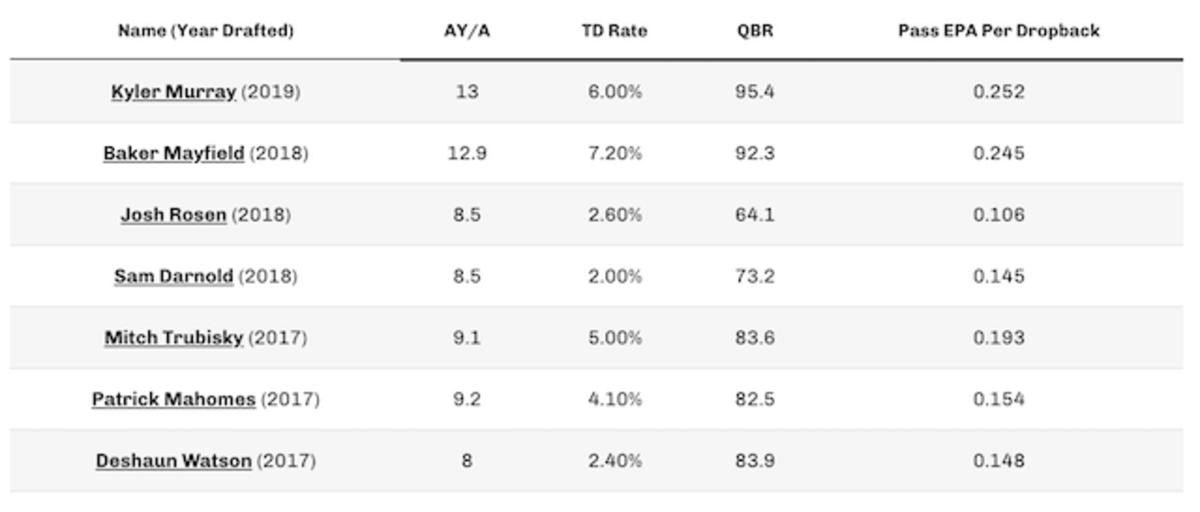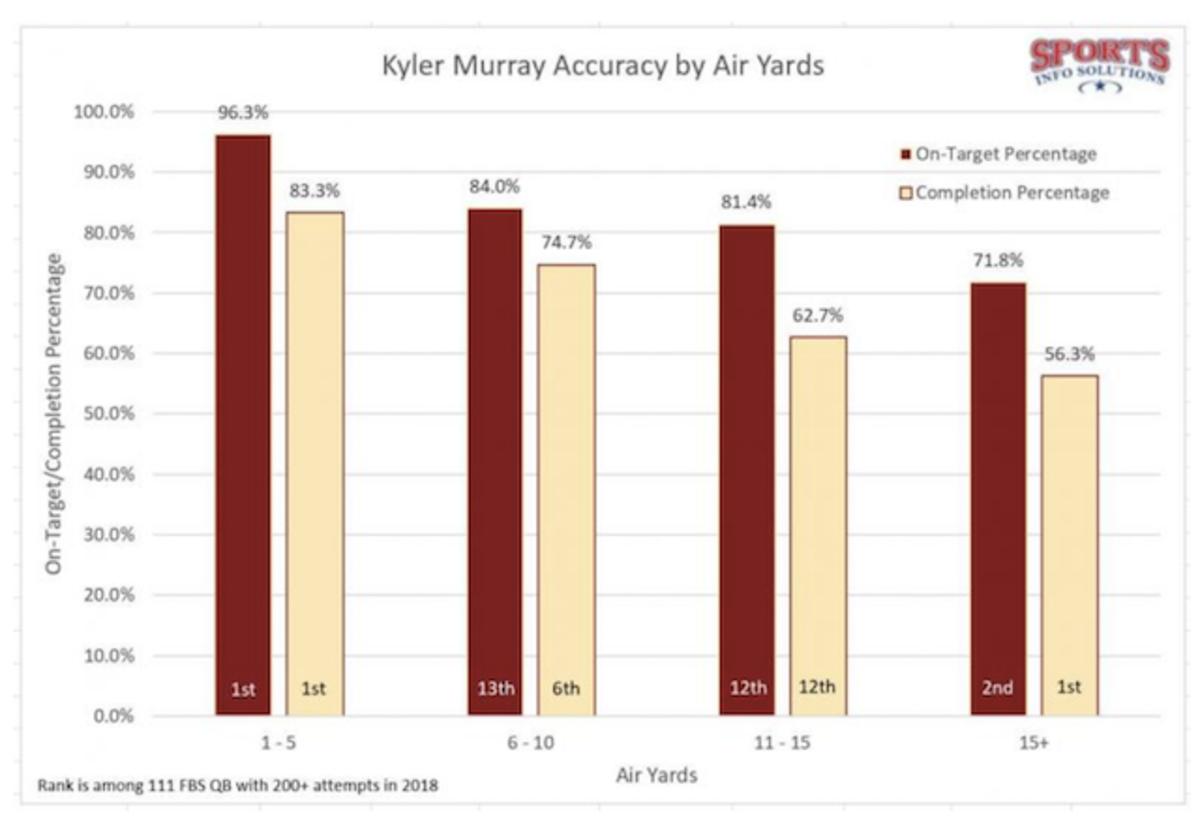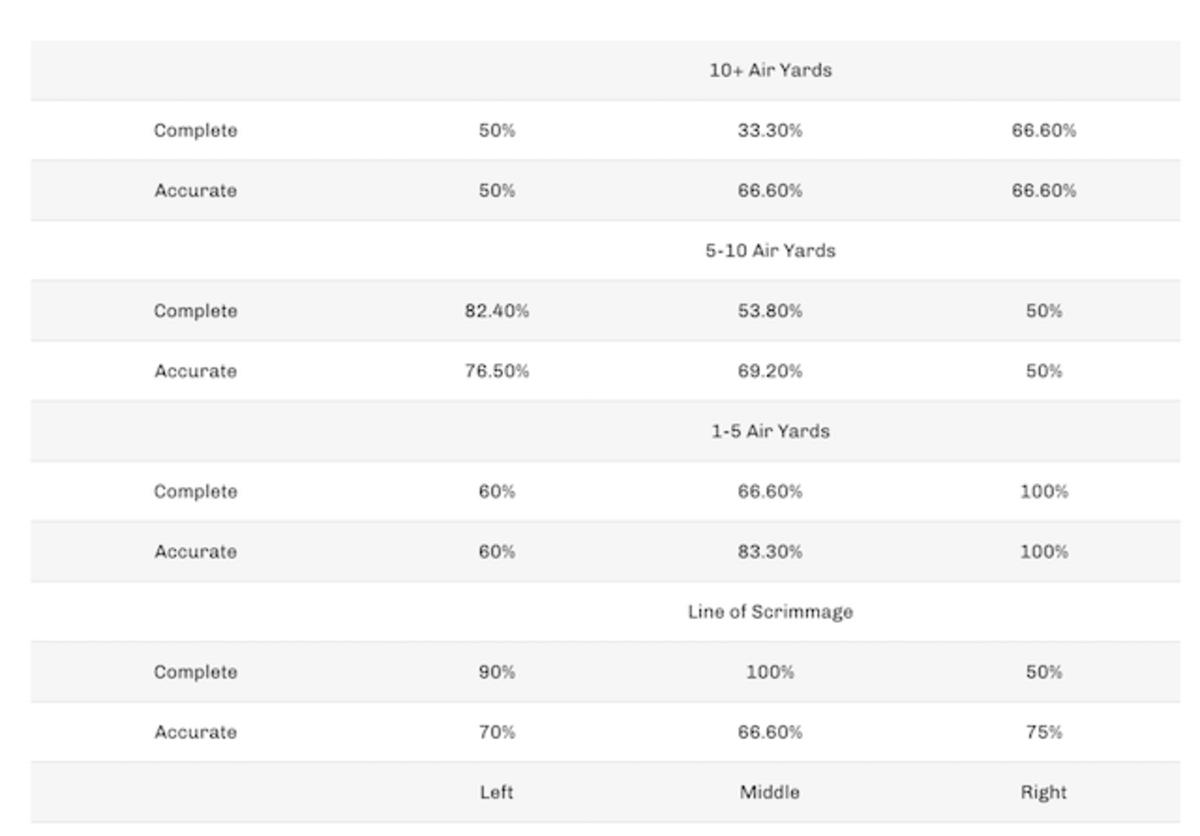A Case for Kyler Murray as an Elite Fantasy Quarterback in 2019

NFL scouting and coaching has come a long way in the modern era. Analytics and evidence-based decision making has improved how some teams approach both in-game play and roster moves. Backfields, once primarily controlled by a single player, have been split into committees with multiple players filling specific roles. Offensive schemes maximize talent with zone and gap reads for wider lanes. And a quarterback's build is no longer a make-or-break proposition.
Once upon a time, quarterbacks were cut from the exact same mold, something around 6'4" and 225 pounds. The belief that a quarterback should meet specific height and weight requirements has given rise to several narratives, two of which stand out most prominently.
"He won’t be able to see his receivers over the linemen."
"He won’t hold up after getting hit by NFL-caliber linebackers and safeties."
Tell that to Drew Brees, Russell Wilson, and Baker Mayfield Those three have challenged the prototype, all subverting it in different ways. And now, on the heels of Mayfield setting the record for touchdown passes by a quarterback, his successor at Oklahoma is ready to flip the position’s evaluation process on its head, possibly sounding the death knell for quarterback-size fanatics.
Let’s take a look at Kyler Murray, the offensive scheme he’ll run in Arizona, and what we can expect in 2019.
The Guy Who Replaced Baker Mayfield
College data doesn’t care about weight or height, just what can be done on the field. Looking at quarterbacks selected in the top-12 picks of the last three drafts, Murray stands above them all.
Quarterbacks selected in the top 12 of the NFL Draft, 2017-19

Efficiency. TD Rate. QBR. Expected Points Added. Mayfield is the only one who comes close to Murray as a total package. His 69% completion rate (second-best in the group) is not only a testament to his skills as a passer, but another knock against the height narrative. From a purely numbers-based approach, the Sooners couldn’t have asked for a better inheritor of Mayfield’s mantle. And, of course, this doesn’t account for the additional production Murray brings with his legs.
Murray’s rushing ability grabbed the attention of the fantasy community before he became the obvious No. 1 pick in the 2019 NFL Draft. The notion of a quarterback who can rush for 1,000 yards in a single season while, at the very least, holding serve as a passer, is already creating hysteria in fantasy leagues. If Josh Allen was able to average 80 rushing yards and a touchdown over the final six games of last season without once topping 250 passing yards, what could Murray do? If Mayfield could break the NFL rookie touchdown record with a receiving corps headlined by a slot receiver, what could Murray do?
The transition from college to the NFL depends on multiple factors, including personnel, coaching and scheme. Murray’s specific skill set also enhances the play design available to his coaching staff. We analyzed three games to illustrate what Murray can do immediately from the jump in the NFL, all of which were against ranked opponents.
10/06/2018 vs. Texas (Neutral Location)
11/23/2018 at West Virginia
12/29/2018 vs. Alabama (Neutral Location)
4for4 Football's award-winning fantasy football rankings are now available for the 2019 season. Get in on the action by subscribing here.
Accuracy
Completion percentage is a binary quantitative metric that simply asks if the intended pass was caught or not. Accuracy asks different questions of the quarterback. The vectors of both the receiver and the surrounding defenders must be accounted for prior to the pass being delivered. A receiver’s ability to extend plays through YAC is correlated to the quarterback’s ability to not only put the ball in the receiver’s hands, but also in his path of motion. The process of throwing, catching and turning downfield must be seamless to maximize the receiver’s talents beyond catching the football. Again, Murray stands out.

Murray’s strong completion percentage—he ranked second in the 2019 class—was complemented by his ability to put his receivers in situations to win. Josh Rosen was unable to do the same while under center for Arizona in 2018.
Josh Rosen's On-Target Percentage by Depth, 2018

To be fair, the defense for Rosen is simple. The team was lacking in both personnel and offensive continuity for most of 2018. Rosen did enter the league with a worse collegiate completion percentage, but this is not an indictment of the player. This serves as an analytical and situational observation, and Murray will benefit in both areas where Rosen was shorted. The Cardinals fired Steve Wilks and replaced him with a forward-thinking, offensive-minded head coach in Kliff Kingsbury, who’s rooted in the same type of scheme in which Murray can thrive. The team also added three receivers and two offensive linemen in the draft, with receivers Andy Isabella and Hakeem Butler likely to be weapons for Murray as rookies. In other words, Murray’s stepping into the positive, supportive situation every rookie quarterback wants. Add in what the Cardinals have retained on offense, and the group should take a massive step forward in 2019.
Improvisation
A common knock against dual-threat quarterbacks is their perceived tendency to tuck and run. ‘First-read-and-go’ quarterbacks, as they’re commonly known, take too many hits by putting themselves in precarious situations. However, a quarterback who’s a rushing threat isn’t automatically a one-read passer. Murray is a dual-threat quarterbacks, someone who is just as dangerous throwing on the run as he is when he takes off with the ball in his hands.
While diagnosing pressure, Murray keeps the ball out and his eyes downfield. Regardless of what he knows he can create with his legs, he understands the greater offensive efficiency associated with the pass. As linebackers move forward in pursuit, throwing lanes open and receivers have one fewer defender on them. His arm strength appears effortless and his ability to adjust to the defense in real time is something Arizona sorely needs. But this same skill can also get the NFL rookie into trouble.
Murray’s consistently keeps his focus downfield, but while navigating the collapsing pocket he has a tendency to hold the ball low and away from his body. He has exhibited progress in this respect, but adjusting to NFL speed can bring back old habits. Murray will be faced with constant pressure behind the Cardinals’ offensive line, and this is one trait that must be monitored during his rookie season.
Speed
It’s no much of a surprise that Murray declined to perform the speed drills throughout the draft process. He's proclaimed himself to have 4.3 speed and it shows as he weaves through traffic.
Murray ran for more than 100 yards and a touchdown in all three charted games. However, he also had the support of one of the best lines in the country, with Oklahoma ranking fourth in adjusted line yards. The Cardinals, conversely, ranked was 25th in the NFL. It’s here where Murray will face his toughest test as a rookie. Defensive coordinators will come at him with pressure, and his response under duress will be illuminating.
The Beginning of a New Age
Murray attempted 86 passes over the three games charted. His completion and accuracy ratings over the sample are provided below.
Passing Chart from Sampled Games

The takeaways from this sample jibe with the consensus analysis. Murray can connect with receivers all over the field. What he’s demonstrated as a passer negates any stature-driven narrative. Of his 86 attempts, two were deflected at the line of scrimmage recorded in the sample. He had a total of five deflected passesin 2018. Daniel Jones (6’5”) had 12. Drew Lock (6’4”) had eight. This speaks to his throwing mechanics being more important than size.
Murray ran every charted pass from either shotgun or pistol formation with a running back and hybrid tight end as extensions of the passing game. This is typical for an air raid offense, which we should expect to see from the Murray-Kingsbury pairing in Arizona. David Johnson receives an instant boost, especially considering he already has a 120-target season to his name. Johnson is an easy first-round pick. The real questions lie with the team’s receivers.
Christian Kirk and Larry Fitzgerald are the likeliest to benefit early on from the new system. It’s no secret that Fitzgerald primarily works out of the slot and operates in the ranges where Murray performs best. Forget about last year. There’s reason to buy into a Fitzgerald renaissance.
Kirk can produce similarly. Kingsbury recruited Kirk out of high school when he was the offensive coordinator and quarterbacks coach at Texas A&M, so there’s already a familiarity. Kirk’s size points towards slot receiver, but his 45.5% slot rate in 2018, as well as Fitzgerald’s presence, suggests otherwise. He had a 69% catch rate from the outside while producing the most first downs by a Cardinals receiver. His versatility will earn him playing time in multiple formations as the offense grows and he continues his rehab from foot surgery.
Andy Isabella and Hakeem Butler, from a schematic fit, are exactly what the offense needs. Isabella is a burner at 5’9”, making him an asset on jet sweeps, crossing patters, and deep outs. The 6’5” Butler, meanwhile, will be dangerous on deep balls and in the red zone. Their fantasy value, however, comes more in buttressing Murray’s prospects than in creating their own.
On paper, everything fits in Arizona. The combination of coach and quarterback. The do-it-all-running back. The diverse receiving corps. The improvements made along the line. It all rests, however, on Murray being who the Cardinals believe he is.
The realities of the NFL—from game speed, to brighter defensive coordinators, to imperfect health—will be challenging, but Murray looks like the best quarterback prospect coming out of college in at least the last three years. With what he’s shown and how Arizona is building around him, he’ll be an impact player in 2019.
